Assumption Mapping
Assumptions mapping provides a powerful technique to identify, categorize and prioritize risky assumptions. This guide explores how creating an assumptions map enables you to test thinking, validate ideas, and increase the likelihood of product-market fit.
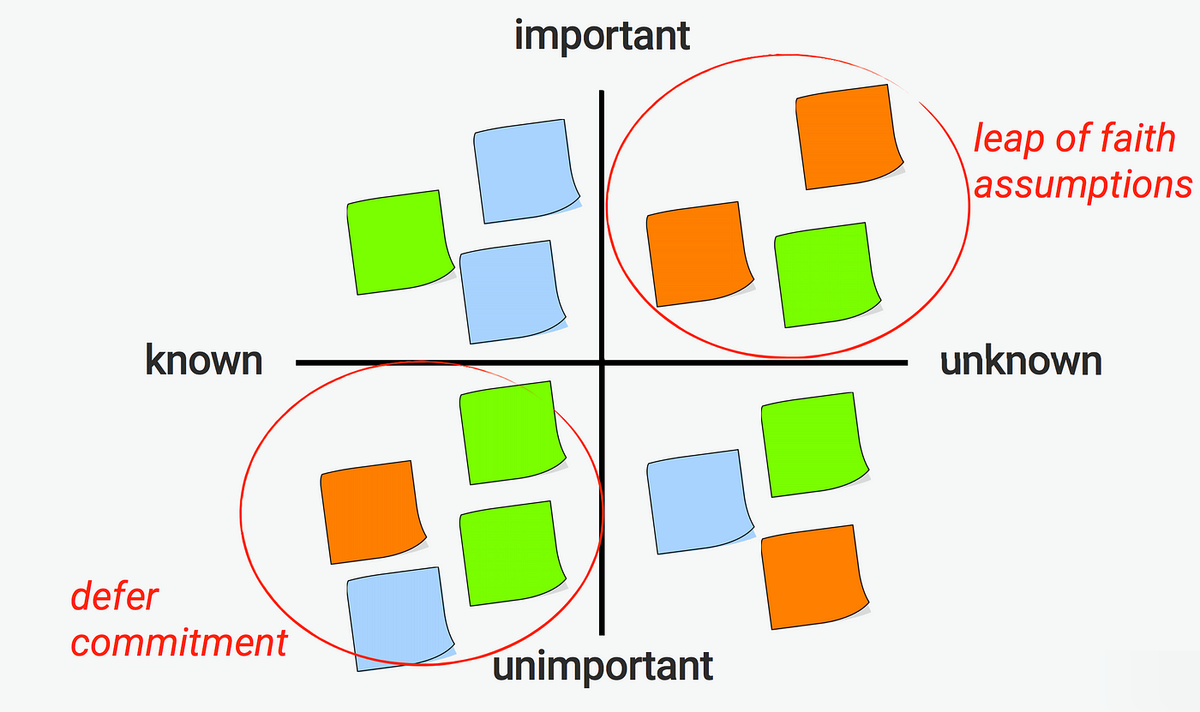
Navigating the uncertain waters of product development can feel like sailing without a map. However, assumptions mapping provides the navigational chart to guide your voyage. This powerful technique enables you to identify, categorize and prioritize the risky assumptions that could sink your product before it ever sees the light of day.
By creating visibility into these potential hazards and focusing energy on mitigating the riskiest ones first, assumptions mapping allows you to test your thinking, validate product ideas, and increase the odds that your offering will resonate in the market. In this comprehensive guide, we will explore how assumptions mapping can transform your product development process to help you reach your destination of delighting customers.
With an assumptions map in hand, you are equipped to navigate uncertainty and chart a course to product-market fit.
Key Takeaways
- Assumption mapping is a strategic approach to assess and prioritize product development risks.
- It involves categorizing assumptions into desirability, viability, and feasibility in order to inform decision-making.
- Testing of risky assumptions through various methods can increase chances of success while reducing risk of failure.
Understanding Assumptions Mapping
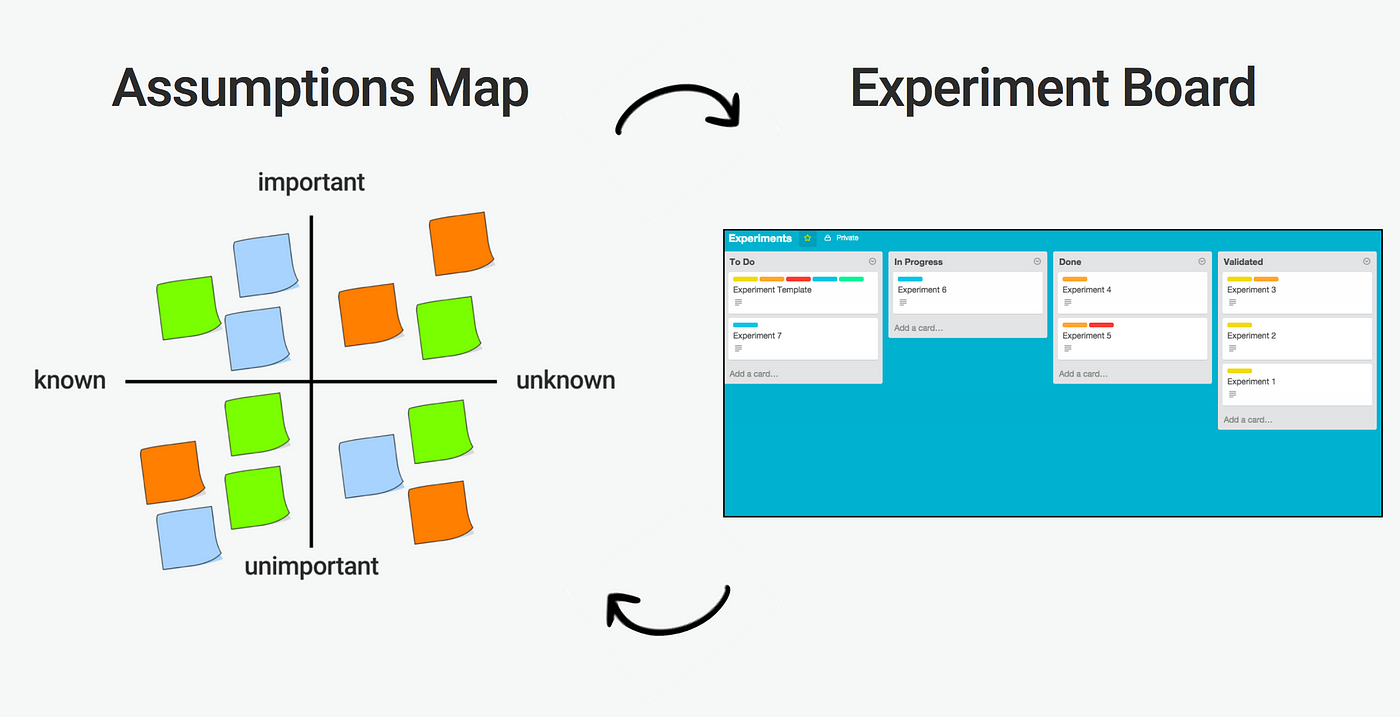
Assumption mapping is a strategic approach that seeks to identify, categorize, and prioritize potential risks associated with product development, focusing on desirability, viability, and feasibility. Attending an assumptions mapping webinar offers deeper insights into this powerful method.
The process involves breaking down assumptions into three main categories: desirability, viability, and feasibility. Grasping each category paves the way for successful product development by enabling you to confront the most significant risks directly.
To make sense of these categories, think of desirability assumptions as focusing on user needs and preferences, viability assumptions on business success and revenue generation, and feasibility assumptions on practical constraints such as technical, legal, and resource limitations. Systematically addressing these assumptions boosts your chances of developing a product that appeals to users and achieves market success.
Desirability Assumptions Focus
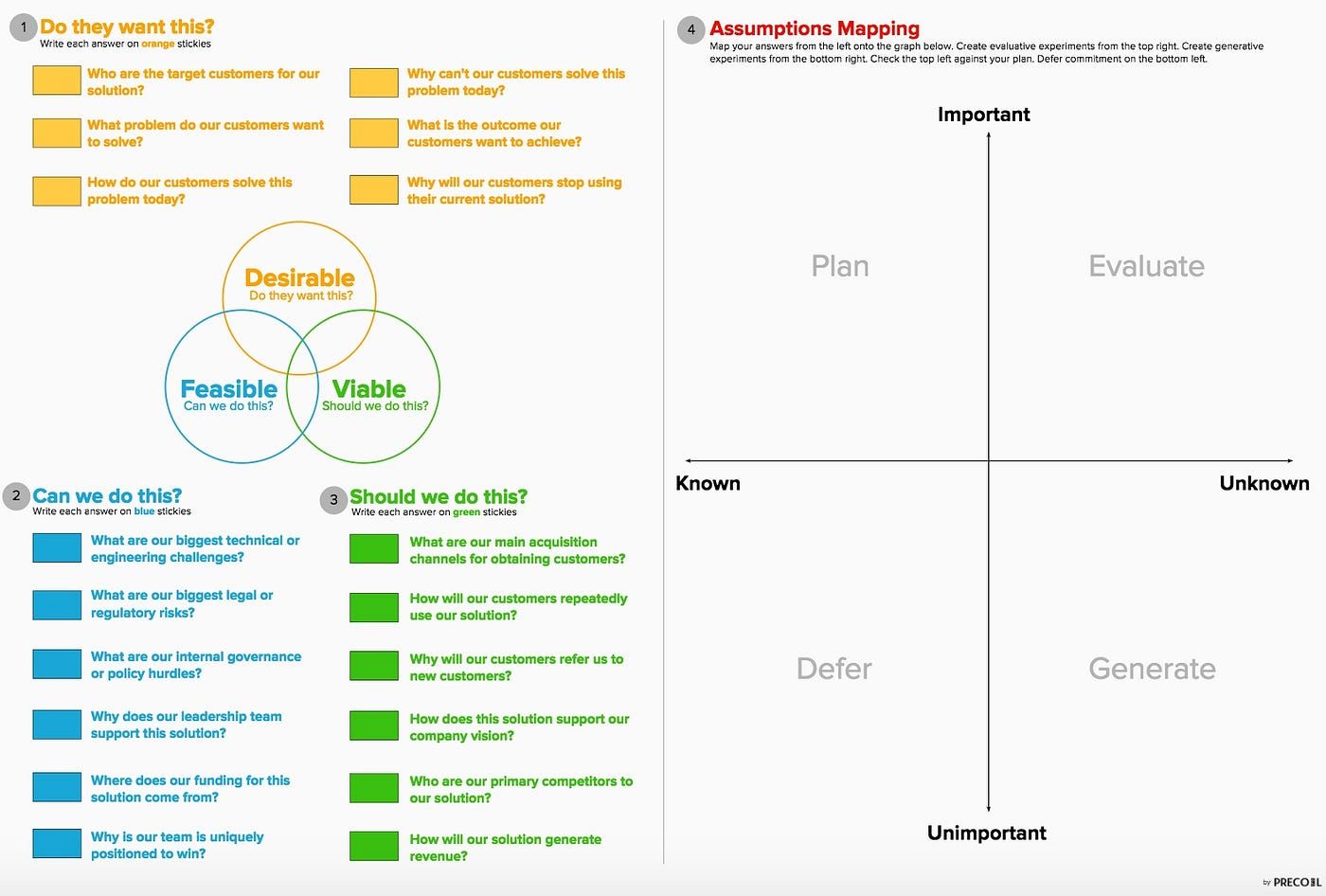
Desirability assumptions investigate user requirements and inclinations, ascertaining if a solution is alluring and pleasurable for the intended audience. For instance, will users find the product’s interface intuitive? Does the product fulfill a genuine need or desire? The identification and evaluation of these assumptions is a fundamental step in creating a product that matches user expectations and differentiates itself in the market.
To effectively tackle desirability assumptions, ask probing questions about user preferences, motivations, and pain points. Designers and user researchers can gain insights into the potential desirability of a product or service by acknowledging and assessing these assumptions, which ensures alignment with the target customers’ needs and preferences.
Remember, the goal is to create a product that users genuinely want, and desirability assumptions are the key to unlocking that potential and ensuring your product’s success.
Viability Assumptions
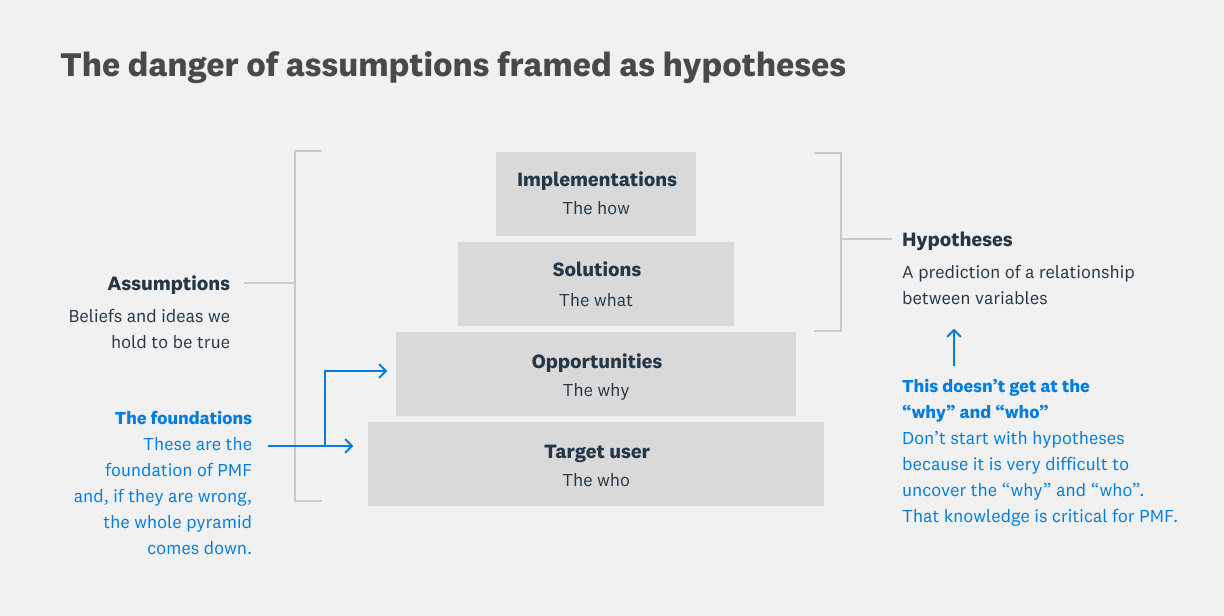
Viability assumptions evaluate the feasibility of business success, revenue generation, and ascertaining development costs. In other words, can your product generate enough revenue to justify its development and ongoing costs? Or, is there a market opportunity that your product can seize? These are the questions that viability assumptions seek to answer.
Before formulating a solution, it’s crucial to ascertain if it’s feasible to create the specified solution with the funds and resources available to your team. Testing feasibility hypotheses is an essential step in this process. Identifying and tackling unknown assumptions related to viability facilitates informed decisions that enhance your product’s chances of market success and help avoid expensive errors.
Feasibility Assumptions
Feasibility assumptions refer to the suppositions made regarding the practicality and viability of a proposed plan or project. These assumptions take into account factors such as technical feasibility, economic justification, and the availability of resources or technology. They assist in determining if a project is feasible and can be successfully implemented.
A critical aspect of feasibility assumptions is the technical investigation. This process helps prevent investing a considerable amount of time and resources into an impractical concept. Technical investigation resolves questions like “Is it feasible to construct?” and “What is the required effort?”. Addressing feasibility assumptions guarantees that your product is not just desirable and viable, but technically robust and achievable as well.
The Value of Assumption Mapping
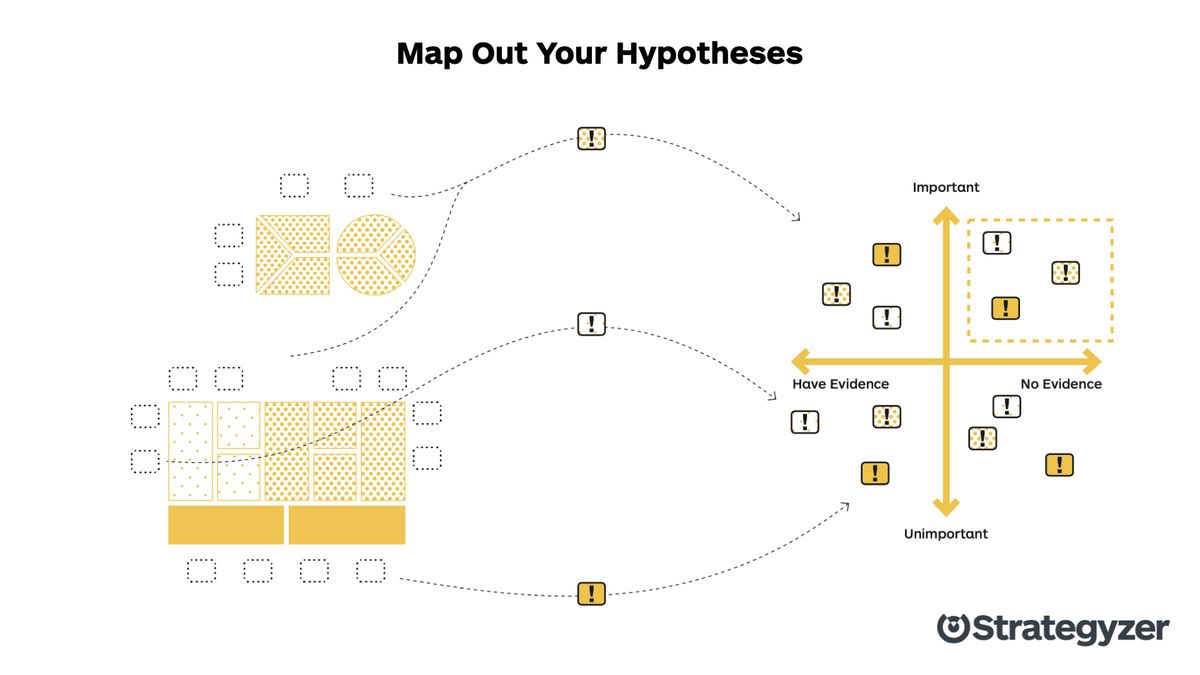
Assumption mapping provides immense value by reducing the expenditure of time and resources, facilitating market research, and permitting the assessment of business ideas before committing to comprehensive development. The systematic identification, categorization, and prioritization of assumptions enable you to make more informed decisions, avoid developing products that customers may not use, and concentrate on the most critical aspects of product development. By creating an assumption map, you can visualize and organize these assumptions for better analysis and decision-making, making assumption mapping important.
Failing to test assumptions in the real world can lead to the creation of a product that customers have no use for. Assumption mapping helps you avoid this pitfall by enabling you to focus on the top right quadrant of the 2x2 diagram, which contains the most important and uncertain assumptions. Prioritizing and testing these high-risk assumptions allows you to validate or disprove critical hypotheses, thereby increasing confidence in your product’s success.
Market Research Integration
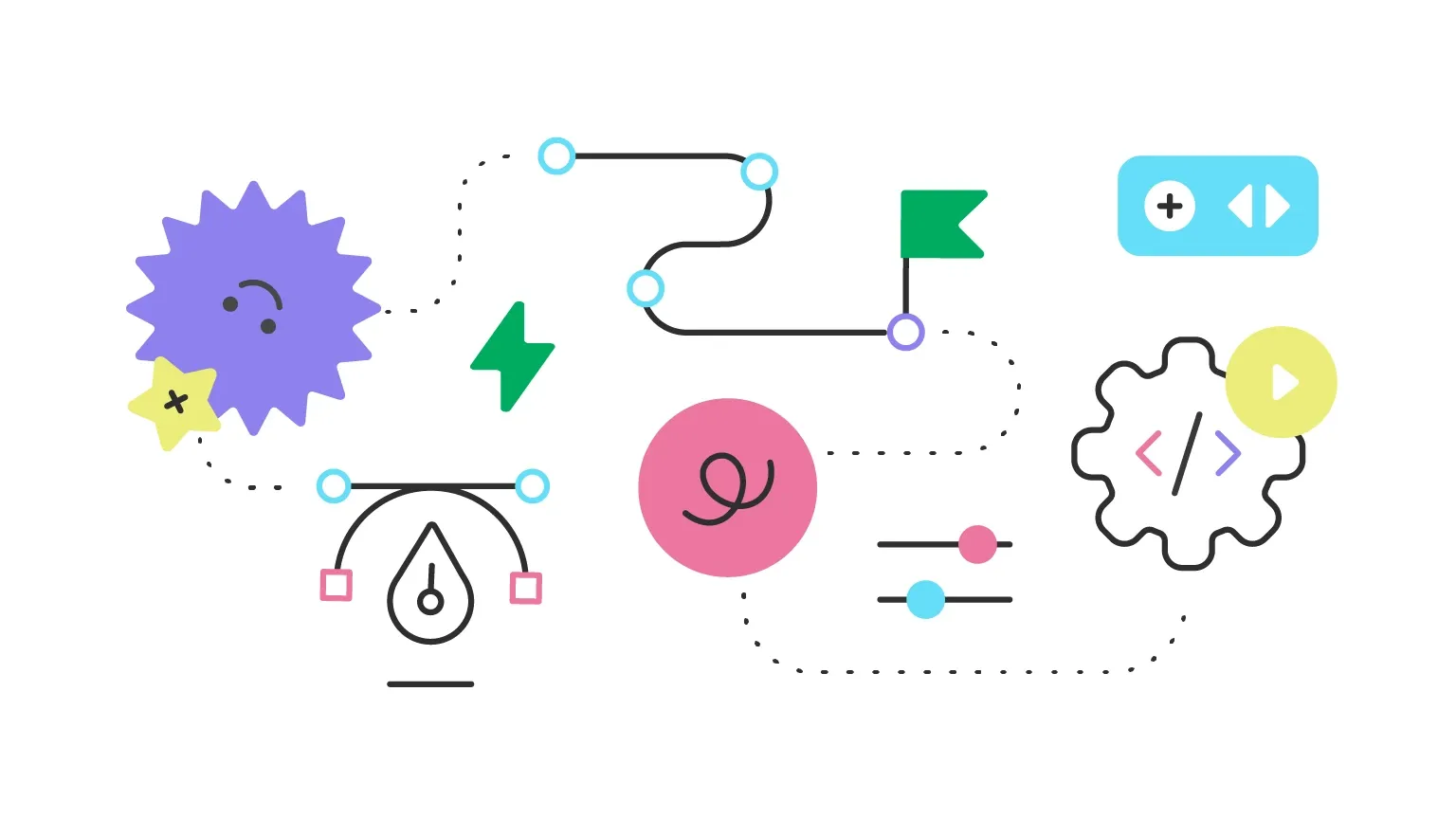
Integrating market research into assumption mapping is essential to validate hypotheses and acquire meaningful information regarding the target audience. This process involves recognizing the assumptions that require testing, procuring data from the intended audience, and examining the data to reach conclusions.
Market research integration can be employed in various ways, such as validating hypotheses regarding customer preferences, recognizing potential opportunities for product or service development, and acquiring insights into customer behavior. Incorporating market research into assumptions mapping enables you to collect valuable insights about your target customers, refine your product strategy, and enhance the probability of success.
Testing Business Ideas

Testing business ideas through assumption mapping allows for the elimination of weak concepts and focusing on those with the highest potential for success. By validating or disproving assumptions, you can streamline your product development process and focus on ideas that truly resonate with your target audience.
Some methods for verifying assumptions, especially when they might be proven false, include constructing a small prototype or minimum viable product (MVP) and assessing it with the intended demographic, employing a landing page, email marketing campaign, or online advertising.
Testing and validating your business ideas before embarking on full-scale development helps save valuable time and resources, mitigates the risk of failure, and ultimately enhances your chances of success.
Step-by-Step Guide to Assumptions Mapping

Now that you understand the importance and benefits of assumptions mapping, let’s explore a step-by-step guide to help you implement this powerful process in your product development journey. The process involves identifying and categorizing assumptions, creating a visual map, and testing risky assumptions through experiments.
The subsequent sections will elaborate on each step of the process, offering insights and guidance on the effective identification, categorization, and testing of your assumptions. Following this guide lays a solid foundation for your product development efforts, maximizing the potential for success while minimizing the risk of failure.
Identifying and Categorizing Assumptions
The initial step in assumptions mapping is to uncover and identify an extensive range of assumptions. To do this, brainstorm potential assumptions about your product’s desirability, viability, and feasibility. Remember to ask critical questions about each aspect, such as “What must be true for the concept to be viable/desirable/feasible/usable?”.
Once you have identified your assumptions, categorize them into desirability, viability, and feasibility. This classification helps you assess the relevance and impact of each assumption, allowing you to prioritize your focus areas and address the most pressing concerns in your product development process.
Creating an Assumptions Map
Creating an assumptions map involves plotting your identified hypotheses based on their importance and available evidence. This visual representation serves to illustrate the assumptions you have identified and organized, helping you recognize the most pertinent assumptions and the connections between them.
To create an assumptions map, follow the steps outlined:
- Document your assumptions.
- Construct a 2x2 diagram.
- Plot your assumptions on the diagram.
- Concentrate on the most hazardous assumptions.
By visually displaying your assumptions and their relationships, you can gain a clearer understanding of the potential risks and opportunities associated with your product or service, enabling more informed decision-making.
Testing Risky Assumptions
Testing high-risk assumptions is essential for validating critical hypotheses and bolstering confidence in your product’s success. To test these assumptions, consider various methods such as:
- A/B testing
- Surveys
- Interviews
- Focus groups Incorporating “testing assumptions” into your strategy ensures a more thorough approach to product validation.
The Riskiest Assumption Test (RAT) approach is another useful method for swiftly identifying and evaluating the most hazardous assumptions and potential flaws for your initiative. By acquiring feedback from users promptly, you can validate or disprove your assumptions and make necessary adjustments to your product or service, saving time and resources in the long run.
Running an Effective Assumptions Workshop

Running an effective assumptions workshop involves thorough preparation and skilled facilitation, ensuring a productive and collaborative session. An assumptions workshop provides a platform for your team to identify and evaluate the assumptions they have regarding a project, product, or service, ultimately leading to a more comprehensive understanding of their legitimacy and potential impact.
The subsequent sections will cover the preparation and facilitation of a successful assumptions workshop. By following these guidelines, you can create an engaging and fruitful session that helps your team uncover and assess their assumptions, resulting in more informed decision-making and improved product outcomes.
Preparing for the Workshop
To prepare for the workshop, start by gathering relevant stakeholders who possess the required knowledge and expertise to contribute to the session. Set clear objectives for the workshop, such as identifying and categorizing assumptions, creating an assumptions map, and testing risky assumptions.
In addition to gathering participants and setting objectives, provide necessary materials and resources for the workshop. This includes:
- A whiteboard
- Markers
- Post-it notes
- Other tools that facilitate brainstorming, categorizing, and prioritizing assumptions
Providing the right materials fosters an environment conducive to creativity and collaboration.
Facilitating the Workshop
As a facilitator, your role is to:
- Guide participants through brainstorming, categorizing, and prioritizing assumptions
- Discuss potential experiments to test high-risk hypotheses
- Encourage open communication and collaboration among participants
- Ensure that all ideas and concerns are heard and considered
As the workshop progresses, help participants identify the most significant risks and formulate experiments to assess them. Executing and evaluating these experiments allows your team to validate or disprove assumptions, leading to more informed decision-making and an increased likelihood of product success.
Remember, the goal is to uncover and address the unknowns, enabling your team to make the best possible decisions for your product or service.
Real-Life Examples of Assumptions Mapping
Real-life examples of assumptions mapping showcase its practical application and effectiveness in various industries, such as online retail and tech startups. These examples demonstrate how assumptions mapping can be applied in different contexts, providing valuable insights and guiding decision-making for product development.
The forthcoming case studies will examine how an online retailer and a tech startup leveraged assumptions mapping to identify and test critical hypotheses about customer preferences and market viability, culminating in successful product launches.
Case Study 1: Online Retailer
In this case study, an online retailer used assumptions mapping to identify and test critical hypotheses about customer preferences and market viability, leading to a successful product launch. By utilizing customer journey maps, the retailer was able to uncover and question assumptions about their customers’ behaviors, preferences, and requirements throughout the purchasing process.
The insights gained from these customer journey maps enabled the retailer to make more informed decisions, resulting in a product that met user expectations and achieved market success. This example illustrates the power of assumptions mapping in guiding product development and ensuring that products resonate with the target audience.
Case Study 2: Tech Startup
A tech startup employed assumptions mapping to prioritize and validate key assumptions about user needs and technical feasibility, resulting in a refined product strategy and focused development efforts. By using assumptions mapping, the startup was able to identify potential risks and opportunities, as well as validate or disprove assumptions before making crucial product decisions.
The outcomes of the tech startup’s assumptions mapping included a more refined product strategy, concentrated development efforts, and a higher probability of success. This case study demonstrates the versatility and effectiveness of assumptions mapping across various industries, highlighting its potential to transform product development and decision-making processes.
Summary
Embarking on product development without questioning assumptions is like sailing uncharted waters - you may reach your destination, but the journey will be fraught with unseen hazards.
Assumptions mapping provides the navigational chart to guide your voyage, enabling you to identify risks and focus energy where it matters most. By creating visibility into assumptions and testing the riskiest ones first, you can validate thinking, refine strategies, and increase the likelihood your offering resonates.
While assumptions mapping requires upfront effort, the potential benefits are immense - reduced wasted time and resources, accelerated learning, and higher odds of delighting customers. So let assumptions mapping chart your course through the uncertain seas of product development.
With this powerful technique by your side, you can navigate complexity with confidence, arrive safely in the harbor of product-market fit, and set sail for customer delight.
Frequently Asked Questions
What is assumptions mapping?
Assumption mapping is a technique that helps identify and classify risky assumptions about a product or business idea in terms of desirability, viability, and feasibility. It is used to inform the creation of better products by understanding any assumptions being made about them. This technique can be used to identify potential risks and opportunities, as well as to inform decision-making. It can also be used to identify areas of uncertainty and to develop strategies to address them. By understanding the assumptions being made, it is
How do you use the assumption map?
To use an assumption map, plot each assumption on the map with the group, asking about the level of certainty and risk associated with it. Focus on the top right quadrant for near term experimentation and create evaluative experiments from these important and unknown assumptions. Check the top left quadrant against your existing plan to ensure that no significant assumptions are missed.
What are the benefits of assumption mapping?
Assumption mapping helps teams become aware of potential risks and make assumptions explicit and visible, thereby allowing them to evaluate their validity and test them through research and validation methods.
What are assumptions examples?
Assumptions are ideas or beliefs we hold to be true without proof, such as assuming the sun will rise tomorrow, or assuming a colleague is capable of completing certain tasks. Examples include believing a person wears glasses due to being a nerd and expecting someone to come home tomorrow.
How should I test risky assumptions?
Test risky assumptions by setting up experiments, building prototypes or MVPs, and seeking feedback from end-users or experts. This will help to verify assumptions and identify potential issues before taking action.
